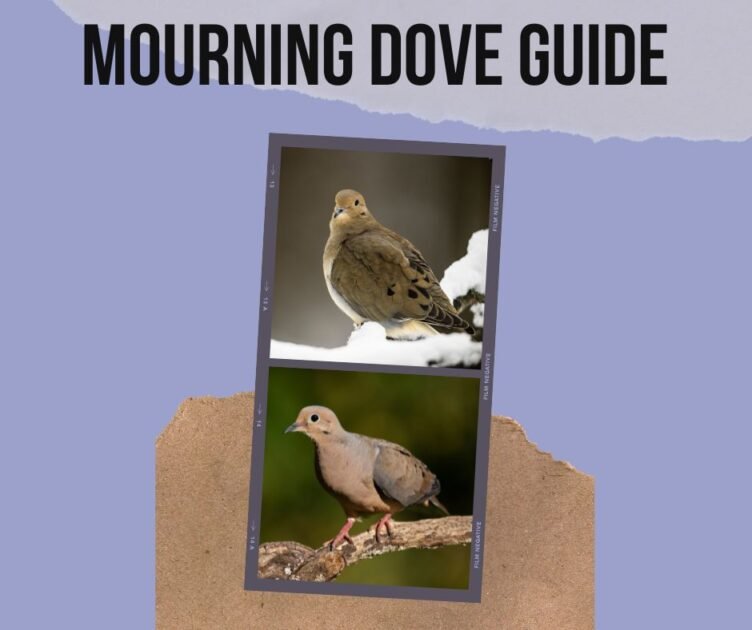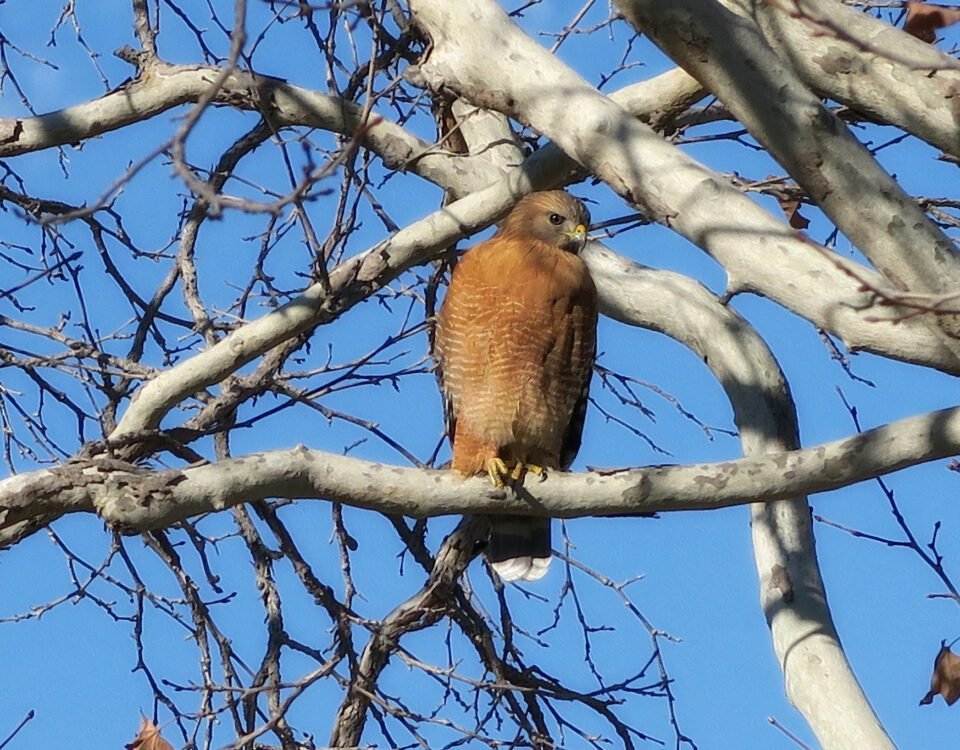


My dog lowers his head and stares: Canine behaviour explained
January 3, 2024


Are Doves Hanging Around Your House? 7 Spiritual Meanings
January 3, 2024Mourning doves, known for their gentle cooing, are a fascinating species with unique habits that captivate bird enthusiasts. This article explores the intimate details of their lives, exploring their nesting, feeding, and mating rituals.
By understanding these aspects, we gain insight into the intricate behaviors that define the mourning dove’s existence, highlighting their importance in the avian world and the delicate balance of nature.
Where Does A Mourning Dove Nest?
Mourning doves typically nest in various locations, including trees, shrubs, vines, ledges, and sometimes on the ground if suitable trees or bushes are lacking. Their nesting height ranges from ground level to over 200 feet.
In the early nesting season, they often prefer the shelter of conifers, but post-leaf-out in deciduous trees, they are equally likely to nest in species like oaks and cottonwoods.


Mourning Dove Nest
Due to their widespread distribution, these birds show significant variability in habitat and nesting preferences. They commonly nest in edge habitats where woodlands meet grasslands, avoiding dense forest interiors.
Mourning doves also adapt to urban environments, nesting in abandoned structures, gutters, and stationary machinery.
Also Read: Where Do Cardinals Nest? [Nesting Habits & Behaviour]
What Does A Mourning Dove’s Nest Look Like?
Mourning dove nests are pretty basic in structure, often resembling a loosely assembled, bowl-shaped platform made from small twigs. These nests are usually situated on the fork of a tree branch or on a ledge.
Sometimes, mourning doves may repurpose an abandoned nest from another bird or even build their nest directly on the ground.
At What Time Does A Mourning Dove Nest?
The nesting season for mourning doves varies depending on the climate of their location. In warmer regions, they typically begin nesting in late February or early March, with the season extending until October.


Mourning Dove on a Branch
In contrast, in colder, northern areas, the nesting season usually starts a bit later, around a month or two after it begins in warmer climates.
Also, Read: Are Doves Hanging Around Your House? 7 Spiritual Meanings
How Long Does A Mourning Dove Nest For?
The nesting period for mourning doves typically spans from early spring to mid-fall, approximately from March to October. A mated pair can have up to five or six clutches throughout this duration.
Each clutch takes about one month to raise, from the start of incubation to the point when the young doves are ready to leave the nest.
How Does A Mourning Dove Build Its Nest?
The construction of a mourning dove’s nest starts with the male selecting potential sites and drawing the female’s attention with his nest-soliciting call.
After the female selects a site, the male gathers building materials such as small twigs, pine needles, and stems, while the female shapes these into a rudimentary bowl structure. Typically, the construction occurs in the morning and is completed within two to four days.
Despite their fragile appearance, these nests support eggs and young birds. Mourning doves often repurpose old nests or return to previous nesting sites. They are also known to occasionally occupy nests originally built by other bird species, such as bluejays, robins, and common grackles.
Must Read: Spiritual Meaning: Bird Nest at Front Door?
How Many Broods Does A Mourning Dove Have?
Mourning doves typically have two to three broods per nesting season on average. However, they can raise as many as five or six broods in warmer climates. Each clutch usually contains just two eggs.


Bird Eggs
It’s common for the eggs to be compromised soon after being laid. In such cases, the female mourning dove can lay a new set of eggs in less than a week. Conversely, if the chicks are lost during the brooding period, it may take the female two to three weeks to clean the nest and prepare for re-laying.
Migration Patterns of Mourning Doves
Mourning doves exhibit a fascinating blend of migratory and resident behaviors, underscoring the adaptability of this species. In general, doves residing in the northern parts of North America tend to migrate southward as winter approaches, seeking warmer climates. This journey can span several hundred miles, showcasing their impressive endurance.
Interestingly, not all mourning doves migrate; some populations in milder regions remain year-round, demonstrating the species’ remarkable adaptability to varying environments. These migration patterns, influenced by temperature and food availability, highlight the mourning dove’s innate ability to thrive in diverse habitats, further cementing their significance in the avian world.
Does A Mourning Dove Build Its Nest At The Same Location Each Year?
Mourning doves return to and reuse the same nesting site annually if they have previously raised a successful brood. It’s common for these birds to consistently come back to a proven site each year. In a year, they may raise up to five broods at the same nest site.
What Does A Mourning Dove’s Eggs Look Like?
Mourning dove eggs are characterized by their solid white color, devoid of markings. They are typically elliptical and measure about 2.6 to 3.0 cm in length and 2.1 to 2.3 cm in width.
What Month Do Mourning Doves Lay Eggs In?
Mourning doves start laying eggs as early as March in warmer areas. In colder climates, laying the first eggs may be delayed until April or May. The nesting season for these birds extends through October, accommodating multiple broods.
Does A Mourning Dove Use Nest Boxes?
Regarding nest boxes, mourning doves are inclined to use platform-style nest boxes. When installing a nest box, it’s advisable to choose a location amidst dense vegetation, such as areas surrounded by trees, shrubs, or hanging plants, to provide necessary cover.
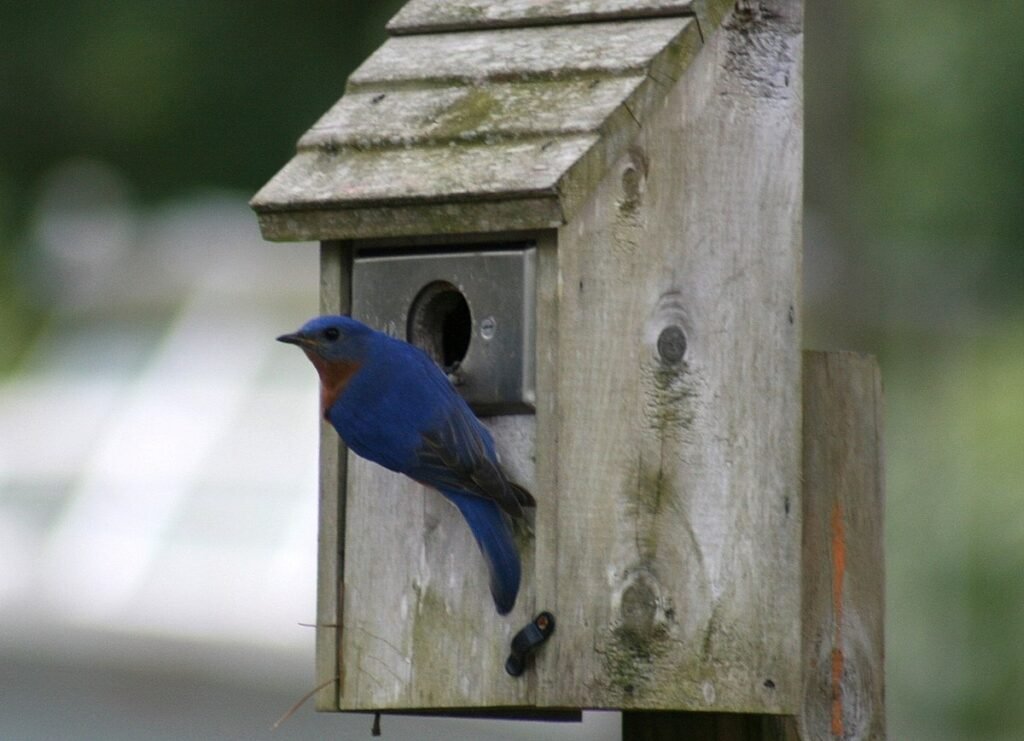

Nest Box
While mourning doves sometimes nest on the ground, placing the nest box at a height of at least ten to fifteen feet above ground is recommended for better protection against predators.
What Do Mourning Doves Feed On?
Mourning doves feed on seeds, which comprise around 99% of their diet. They prefer tiny, oil-rich seeds from grasses, weeds, and occasionally cultivated grains.
They are often seen foraging on the ground for these seeds. In addition to seeds, mourning doves occasionally eat snails and insects, especially during the breeding season, which provides a protein-rich diet for their young.


Chia Seeds
They also need water and can be frequently seen at bird baths or small bodies of water. Their ability to drink water by sucking it up, without needing to tilt their heads back like many other birds, is a distinctive trait.
This efficient drinking method allows them to hydrate quickly, particularly beneficial in hotter climates or arid environments.
Mourning Dove Communication and Vocalization
The soft, haunting coos of the mourning dove are not just a hallmark of their presence but a complex system of communication. These gentle birds use a range of coos, each serving a specific purpose. The primary coo, often heard throughout the day, is a tool for mate attraction and territory establishment.
During courtship, males exhibit a distinctive coo, subtly different in tone, to woo potential mates. Mourning doves also use shorter, sharper calls as alarm signals, alerting others to potential danger. Intriguingly, these vocalizations vary slightly by region, indicating a level of regional adaptation.
Beyond vocal sounds, mourning doves also communicate through body language, such as wing-flapping displays during mating rituals. Understanding these subtle yet intricate vocal and non-vocal cues provides a deeper insight into the social dynamics of these widely admired birds.
Do Mourning Doves Mate For Life?
Mourning doves form strong pair bonds and are generally monogamous, staying with the same mate for a breeding season. However, they do not necessarily mate for life in the strictest sense. The remaining dove usually finds a new partner if one mate dies or is lost.
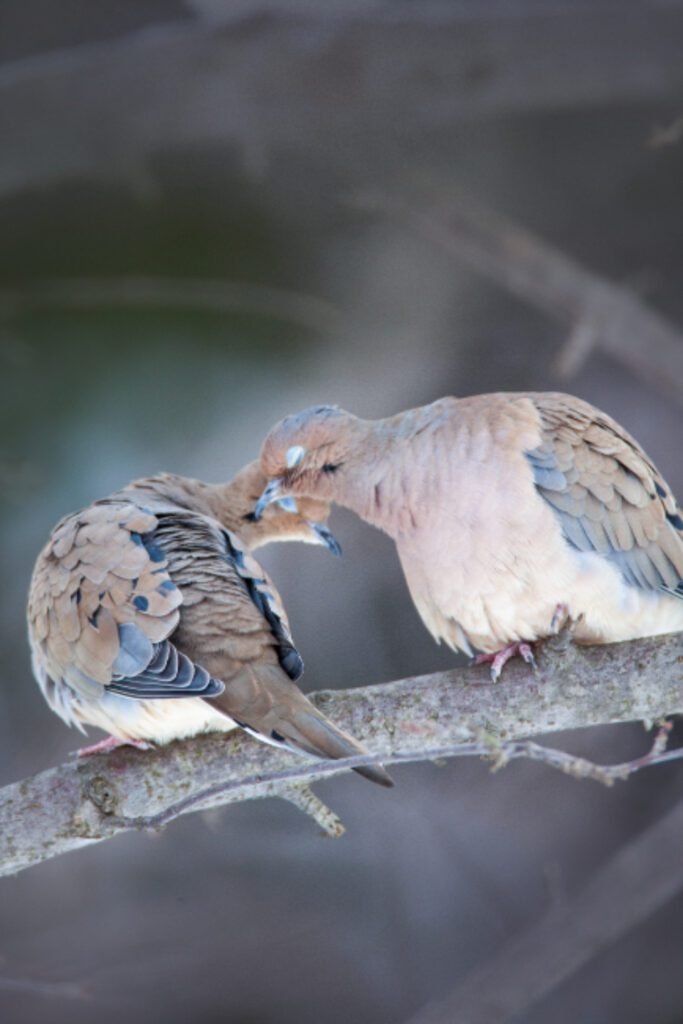

Mourning Dove Mating
Also, the bond is typically for the duration of the breeding season, and it’s not uncommon for mourning doves to choose different partners in subsequent breeding seasons. Their loyalty to a partner tends to be more practical and seasonally based rather than a lifelong commitment.
Related Read: How to Actually Become a Bird Breeder: A-Z Guide
Mourning Dove Symbolism and Cultural Significance
The mourning dove, known for its poignant cooing, holds a rich tapestry of symbolism across cultures. Often seen as a messenger of peace and hope, its gentle call is also emblematic of longing and sorrow, resonating deeply in art and literature. In many traditions, these birds are symbols of renewal and new beginnings, as beautifully explored in Native American folklore.
Their adaptability, thriving in varied habitats, further underscores their symbolism of resilience. For a more profound exploration of the mourning dove’s spiritual significance, visit Mourning Dove Spiritual Meaning, which explores the deeper symbolic interpretations of this serene and meaningful bird.
Health and Longevity of Mourning Doves
Mourning doves typically live for 1 to 1.5 years in the wild, with some reaching up to 5 years. Their lifespan is influenced by factors like environmental conditions, predation, and diseases such as parasitic infections and avian pox.
In captivity, with proper care, they can live longer due to reduced threats and better health management. Adequate nutrition and clean water are crucial for their health. Despite their adaptability to various habitats, they face diverse health risks, highlighting the importance of conservation and care for this species.
What Happens When One Of The Pair Dies?
When one member of a mourning dove pair dies, the surviving dove will typically seek a new mate. Mourning doves are primarily monogamous for the breeding season, so losing a mate requires finding another partner to continue reproducing and raising young.
Finding a new mate usually happens quite quickly, especially during the breeding season, as the urge to reproduce and the need for assistance in nesting and rearing young are strong drivers for these birds.
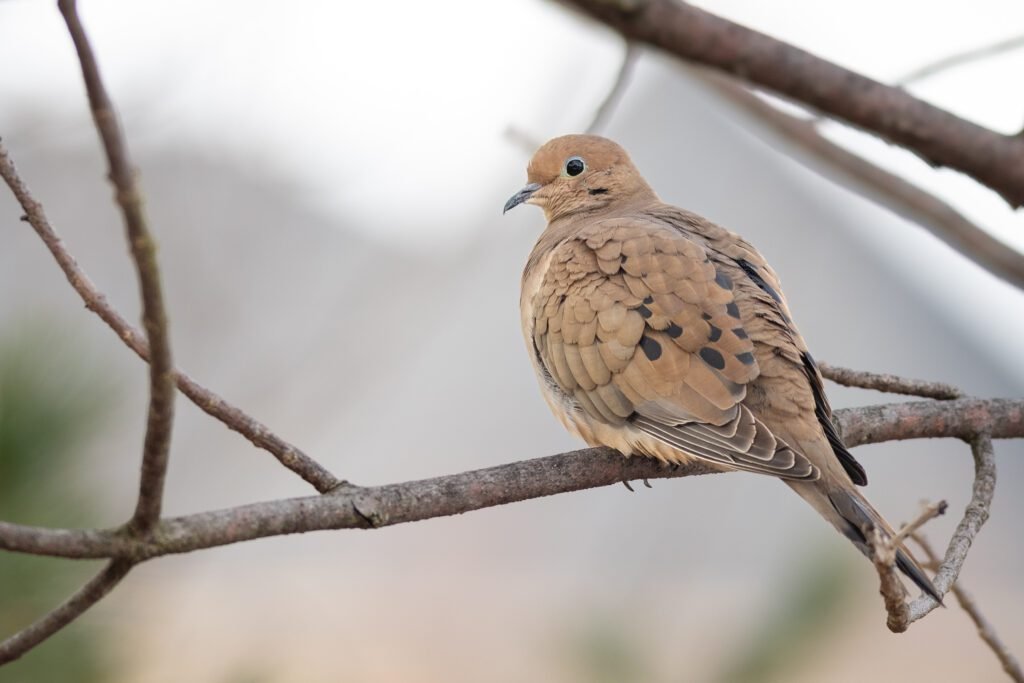

Mourning Dove on Tree
While mourning doves show signs of distress or searching behavior when a mate is lost, their survival and reproductive instincts often lead them to pair up with a new mate soon after losing their previous one.
The social structure and behavior of mourning doves are geared towards maximizing reproductive success, including the ability to adapt to the loss of a mate and re-pair as needed.
Conservation Status and Efforts of Mourning Doves
Mourning doves are currently classified as a species of least concern by the International Union for Conservation of Nature (IUCN), indicating a stable population.
However, they face challenges such as habitat loss, environmental changes, and hunting pressures in certain regions. Conservation efforts focus on habitat preservation and management, ensuring adequate food sources and nesting sites.
Regulations on hunting and the protection of significant breeding grounds play a crucial role in maintaining their population. In urban areas, initiatives to create bird-friendly environments help support their numbers.
Continuous monitoring and research are essential to understand population trends and address emerging threats. These collective efforts ensure the mourning dove remains an integral part of the ecosystem.
Also, Read: Everything You Need to Know About Birds’ Heat Cycles
Conclusion
In conclusion, mourning doves are a fascinating avian species, showcasing intriguing nesting, mating, and feeding behaviors. From their simple, reused nests to their monogamous yet adaptable pairing habits and predominantly seed-based diet, these birds exemplify a harmonious balance between adaptability and consistency in the natural world.
